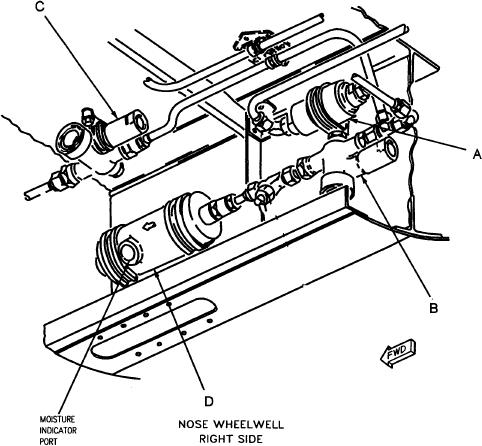
particles larger than 10 microns. When the filter
WAVEGUIDE PRESSURIZATION
element is contaminated, a pressure differential of 4 to
SYSTEM
5 psi will open a relief valve and bypass air around the
LEARNING OBJECTIVE: Identify the
filter element without interrupting system operation.
waveguide pressurization system and its com-
ponents.
Waveguide Fluid Pressure Regulating Valve
The purpose of the F-18 waveguide pressurization
The ECM (fig. 5-26, item B) and radar (fig. 5-26,
system (fig. 5-25) is to contain and transport the
item C) waveguide pressure regulating valves are
regulated, filtered, dry air to the radar and electronic
located in the nose wheelwell and function identically.
countermeasures (ECM) waveguide cavities.
One is for the ECM waveguide and the other is for the
radar waveguide. These waveguide fluid pressure
COMPONENTS
regulating valves receive filtered muscle pressure
The waveguide pressurization system is made up of
airflow and regulate this airflow from 0.3 to 4.3 pounds
a filter, two pressure regulating valves, two desiccators,
per square inch absolute (psia) outlet pressure. Each
two ground test ports and tubing.
waveguide fluid pressure regulating valve has two
aneroid assemblies to regulate air pressure. Primary
Avionics Pressurization Filter Assembly
aneroid assembly force is balanced against spring force
through an orifice on which a ball is seated. An
The avionics pressurization filter assembly (fig.
auxiliary aneroid assembly functions as an added
5-26, item A) in the nose wheelwell is made up of a
adjustment and as a trigger assembly to allow internal
filter element and a relief valve. During normal
pressure relief to atmosphere if regulated pressure
operation, regulated muscle pressure from the
exceeds 4.3 psia. A resettable indicator is visible when
flow/temperature limiting anti-ice modulating valve
an overpressure condition has occurred. A check valve
(windshield anti-ice/rain removal system) passes
next to the outlet port of the waveguide fluid pressure
through the filter element, which removes 100 percent
regulating valve closes to maintain waveguide pressure
of particles larger than 25 microns and 98 percent of
during an overpressure condition.
Figure 5-26.--Waveguide pressurization system component locator.
5-23

